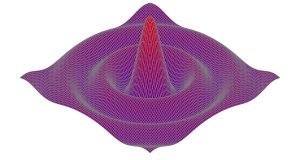高さに基づくポリゴンの色付け
Go 「プログラミング言語Go」の練習問題3.3の解答を作成しました。「gopl.io/ch3/surface」に、ポリゴンの中心点の高さに基づいて色を返す関数を追加して、SVGの
「プログラミング言語Go」の練習問題3.3の解答を作成しました。「gopl.io/ch3/surface」に、ポリゴンの中心点の高さに基づいて色を返す関数を追加して、SVGの polygon のところに style=\"fill: #%v; storoke: black;\" を追加したものです。
|
1 2 3 4 5 6 7 8 9 10 11 12 13 14 15 16 17 18 19 20 21 22 23 24 25 26 27 28 29 30 31 32 33 34 35 36 37 38 39 40 41 42 43 44 45 46 47 48 49 50 51 52 53 54 55 56 57 58 59 60 61 62 63 64 65 66 67 68 69 70 71 72 73 74 75 76 77 78 79 80 81 82 83 84 85 86 87 88 89 90 91 92 93 94 95 96 97 98 99 100 101 102 103 |
// Copyright © 2016 Alan A. A. Donovan & Brian W. Kernighan. // License: https://creativecommons.org/licenses/by-nc-sa/4.0/ // このプログラムは Alan A. A. Donovan & Brian W. Kernighan による gopl.io/ch3/surface を // 改変したものです。 // Exercise 3.3 (p.67) // $ go run main.go > a.svg package main import ( "fmt" "math" ) const ( width, height = 600, 320 // canvas size in pixels cells = 100 // number of grid cells xyrange = 30.0 // axis ranges (-xyrange..+xyrange) xyscale = width / 2 / xyrange // pixels per x or y unit zscale = height * 0.4 // pixels per z unit angle = math.Pi / 6 // angle of x, y axes (=30°) ) var sin30, cos30 = math.Sin(angle), math.Cos(angle) // sin(30°), cos(30°) func main() { fmt.Printf("<svg xmlns='http://www.w3.org/2000/svg' "+ "style='stroke: grey; fill: white; stroke-width: 0.7' "+ "width='%d' height='%d'>", width, height) for i := 0; i < cells; i++ { for j := 0; j < cells; j++ { ax, ay, aok := corner(i+1, j) bx, by, bok := corner(i, j) cx, cy, cok := corner(i, j+1) dx, dy, dok := corner(i+1, j+1) rgb, rgbok := color(i, j) if !rgbok { rgb = "ffffff" } if aok && bok && cok && dok { fmt.Printf("<polygon points=\"%g,%g %g,%g %g,%g %g,%g\" "+ "style=\"fill: #%v; storoke: black;\" />\n", ax, ay, bx, by, cx, cy, dx, dy, rgb) } } } fmt.Println("</svg>") } func color(i, j int) (string, bool) { // Find point (x,y) at corner of cell (i,j). x1 := xyrange * (float64(i)/cells - 0.5) x2 := xyrange * (float64(i+1)/cells - 0.5) y1 := xyrange * (float64(j)/cells - 0.5) y2 := xyrange * (float64(j+1)/cells - 0.5) // Compute surface height z. z1, ok1 := f(x1, y1) z2, ok2 := f(x1, y2) z3, ok3 := f(x2, y1) z4, ok4 := f(x2, y2) if !ok1 || !ok2 || !ok3 || !ok4 { return "", false } z := (z1 + z2 + z3 + z4) / 4 zmax := (height / 2) / zscale red := int(0xff * (z/(2*zmax) + 0.5)) green := int(0x00) blue := int(0xff * (-z/(2*zmax) + 0.5)) return fmt.Sprintf("%02x%02x%02x", red, green, blue), true } func corner(i, j int) (float64, float64, bool) { // Find point (x,y) at corner of cell (i,j). x := xyrange * (float64(i)/cells - 0.5) y := xyrange * (float64(j)/cells - 0.5) // Compute surface height z. z, ok := f(x, y) if !ok { return 0, 0, false } // Project (x,y,z) isometrically onto 2-D SVG canvas (sx,sy). sx := width/2 + (x-y)*cos30*xyscale sy := height/2 + (x+y)*sin30*xyscale - z*zscale return sx, sy, true } func f(x, y float64) (float64, bool) { r := math.Hypot(x, y) // distance from (0,0) if r == 0 { return 0, false } return math.Sin(r) / r, true } |
参考文献
- 「プログラミング言語Go」 Alan A.A. Donovan (著), Brian W. Kernighan (著), 柴田 芳樹 (翻訳)
- 「SVGエッセンシャルズ 第2版」 J. David Eisenberg (著), Amelia Bellamy-Royds (著), 原 隆文 (翻訳)